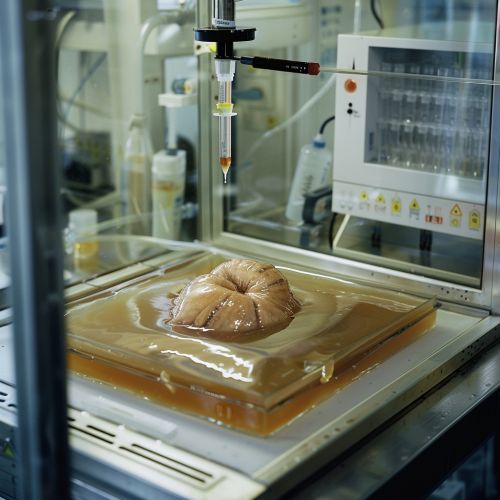Organ culture
Overview
Organ culture is a development in cell culture techniques where whole organs are maintained in vitro in a suitable environment for a certain period. This method allows the study of the physiology and pathology of organs under controlled conditions, and it has been instrumental in the field of tissue engineering and regenerative medicine.
History
The concept of organ culture was introduced in the early 20th century, with the first successful organ culture performed by Ross G. Harrison in 1912. He cultured frog nerve fibers in a lymph drop hanging from a cover slip above a reservoir of Ringer’s solution. This method, known as the hanging drop technique, marked the beginning of organ culture.
Techniques
Organ culture techniques can be divided into three main types: the explant technique, the organotypic (raft) culture, and the whole organ culture.
Explant Technique
In the explant technique, small pieces of tissue are directly placed onto the surface of the culture medium. The tissue pieces adhere to the medium, and cells migrate out onto the surface of the medium. This technique is used to study the interaction of cells within a tissue.
Organotypic Culture
Organotypic culture, also known as raft culture, involves the culture of cells or tissues in a three-dimensional environment. This method allows cells to maintain their in vivo architecture, making it useful for studying tissue function, structure, and development.
Whole Organ Culture
Whole organ culture involves the culture of an entire organ in a suitable medium. This technique is used to study the function and pathology of organs, and it has been instrumental in the field of organ transplantation.

Applications
Organ culture has numerous applications in various fields of biomedical research.
Drug Testing
Organ culture provides a suitable platform for drug discovery and testing. It allows for the testing of drug effects on a whole organ, providing a more accurate representation of drug effects in vivo.
Tissue Engineering and Regenerative Medicine
Organ culture plays a crucial role in tissue engineering and regenerative medicine. It allows for the study of tissue growth and development, and it is used in the development of artificial organs.
Disease Modelling
Organ culture can be used to model diseases in vitro. This allows for the study of disease progression and the testing of potential treatments.
Advantages and Disadvantages
Like any other scientific method, organ culture comes with its advantages and disadvantages.
Advantages
Organ culture allows for the study of whole organs in a controlled environment. It provides a more accurate representation of in vivo conditions compared to cell culture. It also allows for the study of cell-cell and cell-matrix interactions within a tissue.
Disadvantages
Organ culture is a complex and time-consuming process. It requires a sterile environment and careful handling to prevent contamination. Also, not all organs can be cultured successfully, and the culture of certain organs may require specific conditions.
Future Perspectives
The future of organ culture lies in the field of organ-on-a-chip technology. This technology aims to create miniaturized versions of human organs on microchips, allowing for high-throughput testing of drugs and therapies. This could revolutionize the fields of drug discovery and regenerative medicine.
